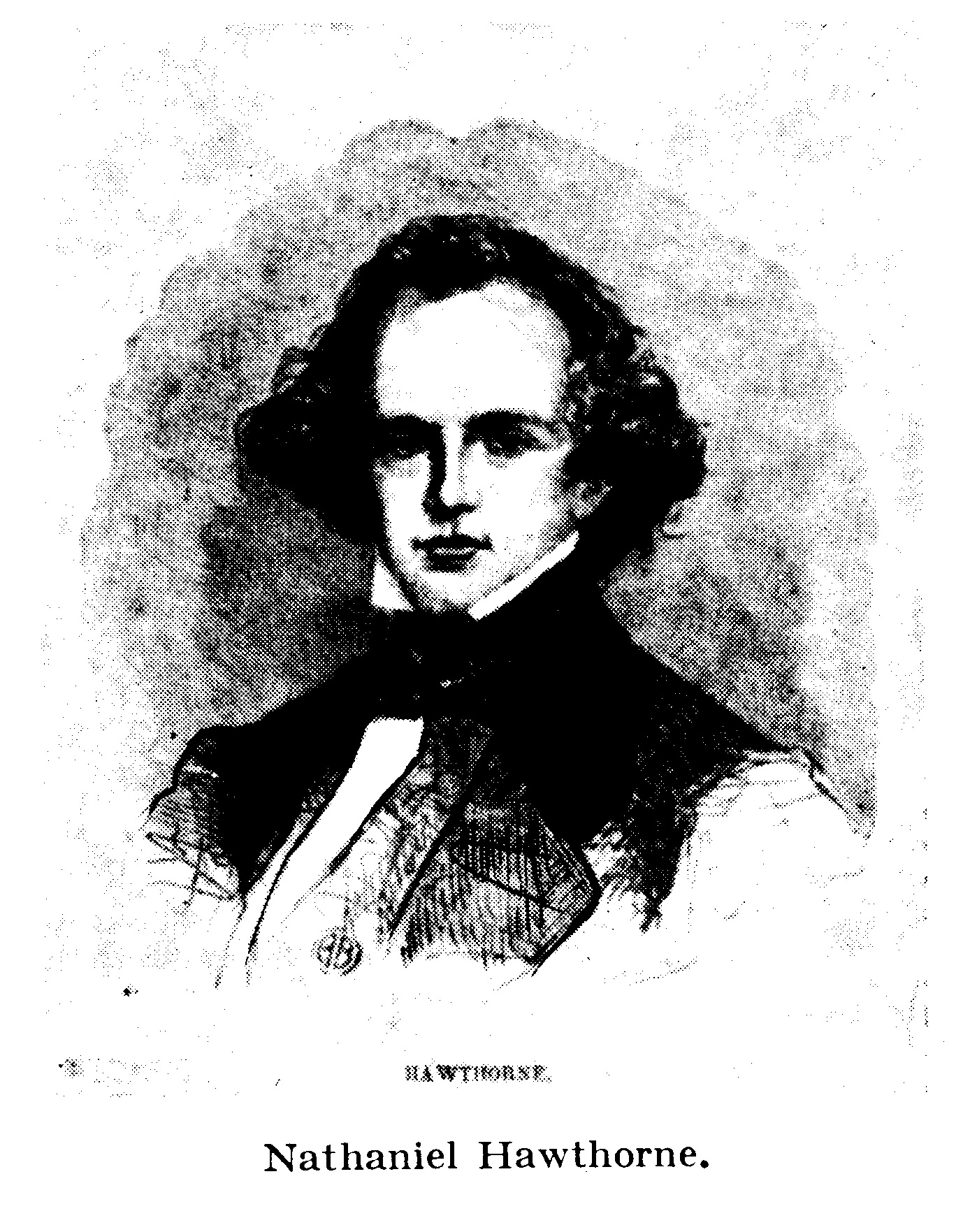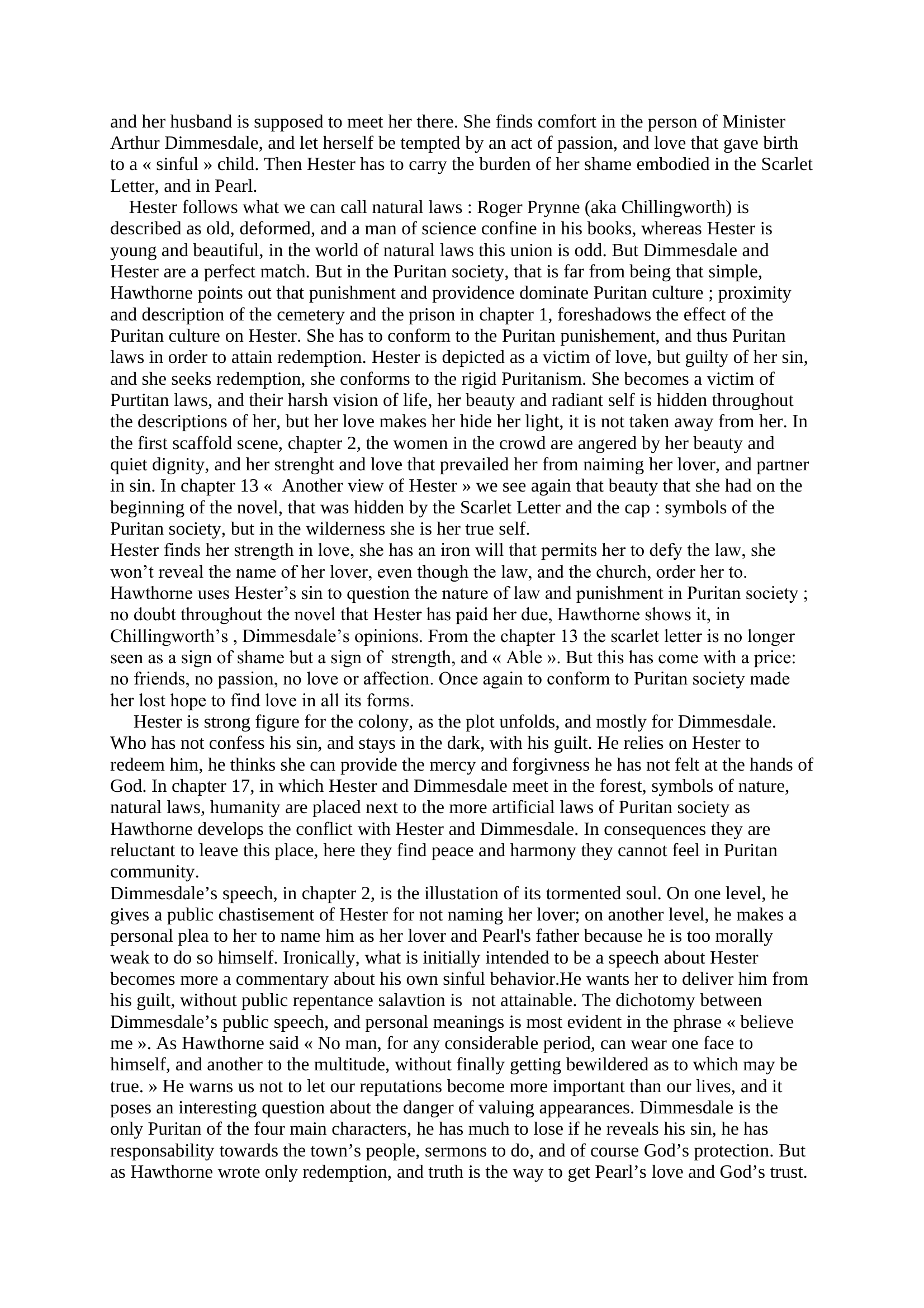Nathaniel Hawthorne The Scarlet Letter Essay
Publié le 04/01/2015

Extrait du document


«
and her husband is supposed to meet her there.
She finds comfort in the person of Minister
Arthur Dimmesdale, and let herself be tempted by an act of passion, and love that gave birth
to a « sinful » child.
Then Hester has to carry the burden of her shame embodied in the Scarlet
Letter, and in Pearl.
Hester follows what we can call natural laws : Roger Prynne (aka Chillingworth) is
described as old, deformed, and a man of science confine in his books, whereas Hester is
young and beautiful, in the world of natural laws this union is odd.
But Dimmesdale and
Hester are a perfect match.
But in the Puritan society, that is far from being that simple,
Hawthorne points out that punishment and providence dominate Puritan culture ; proximity
and description of the cemetery and the prison in chapter 1, foreshadows the effect of the
Puritan culture on Hester.
She has to conform to the Puritan punishement, and thus Puritan
laws in order to attain redemption.
Hester is depicted as a victim of love, but guilty of her sin,
and she seeks redemption, she conforms to the rigid Puritanism.
She becomes a victim of
Purtitan laws, and their harsh vision of life, her beauty and radiant self is hidden throughout
the descriptions of her, but her love makes her hide her light, it is not taken away from her.
In
the first scaffold scene, chapter 2, the women in the crowd are angered by her beauty and
quiet dignity, and her strenght and love that prevailed her from naiming her lover, and partner
in sin.
In chapter 13 « Another view of Hester » we see again that beauty that she had on the
beginning of the novel, that was hidden by the Scarlet Letter and the cap : symbols of the
Puritan society, but in the wilderness she is her true self.
Hester finds her strength in love, she has an iron will that permits her to defy the law, she
won’t reveal the name of her lover, even though the law, and the church, order her to.
Hawthorne uses Hester’s sin to question the nature of law and punishment in Puritan society ;
no doubt throughout the novel that Hester has paid her due, Hawthorne shows it, in
Chillingworth’s , Dimmesdale’s opinions.
From the chapter 13 the scarlet letter is no longer
seen as a sign of shame but a sign of strength, and « Able ».
But this has come with a price:
no friends, no passion, no love or affection.
Once again to conform to Puritan society made
her lost hope to find love in all its forms.
Hester is strong figure for the colony, as the plot unfolds, and mostly for Dimmesdale.
Who has not confess his sin, and stays in the dark, with his guilt.
He relies on Hester to
redeem him, he thinks she can provide the mercy and forgivness he has not felt at the hands of
God.
In chapter 17, in which Hester and Dimmesdale meet in the forest, symbols of nature,
natural laws, humanity are placed next to the more artificial laws of Puritan society as
Hawthorne develops the conflict with Hester and Dimmesdale.
In consequences they are
reluctant to leave this place, here they find peace and harmony they cannot feel in Puritan
community.
Dimmesdale’s speech, in chapter 2, is the illustation of its tormented soul.
On one level, he
gives a public chastisement of Hester for not naming her lover; on another level, he makes a
personal plea to her to name him as her lover and Pearl's father because he is too morally
weak to do so himself.
Ironically, what is initially intended to be a speech about Hester
becomes more a commentary about his own sinful behavior.He wants her to deliver him from
his guilt, without public repentance salavtion is not attainable.
The dichotomy between
Dimmesdale’s public speech, and personal meanings is most evident in the phrase « believe
me ».
As Hawthorne said « No man, for any considerable period, can wear one face to
himself, and another to the multitude, without finally getting bewildered as to which may be
true.
» He warns us not to let our reputations become more important than our lives, and it
poses an interesting question about the danger of valuing appearances.
Dimmesdale is the
only Puritan of the four main characters, he has much to lose if he reveals his sin, he has
responsability towards the town’s people, sermons to do, and of course God’s protection.
But
as Hawthorne wrote only redemption, and truth is the way to get Pearl’s love and God’s trust..
»
↓↓↓ APERÇU DU DOCUMENT ↓↓↓
Liens utiles
- From The Scarlet Letter - anthology.
- Nathaniel Hawthorne I INTRODUCTION Nathaniel Hawthorne (1804-1864), American novelist, whose works are deeply concerned with the ethical problems of sin, punishment, and atonement.
- the scarlet letter chap 21
- Essay Islam in the UK
- Essay: The Way Up to Heaven

































